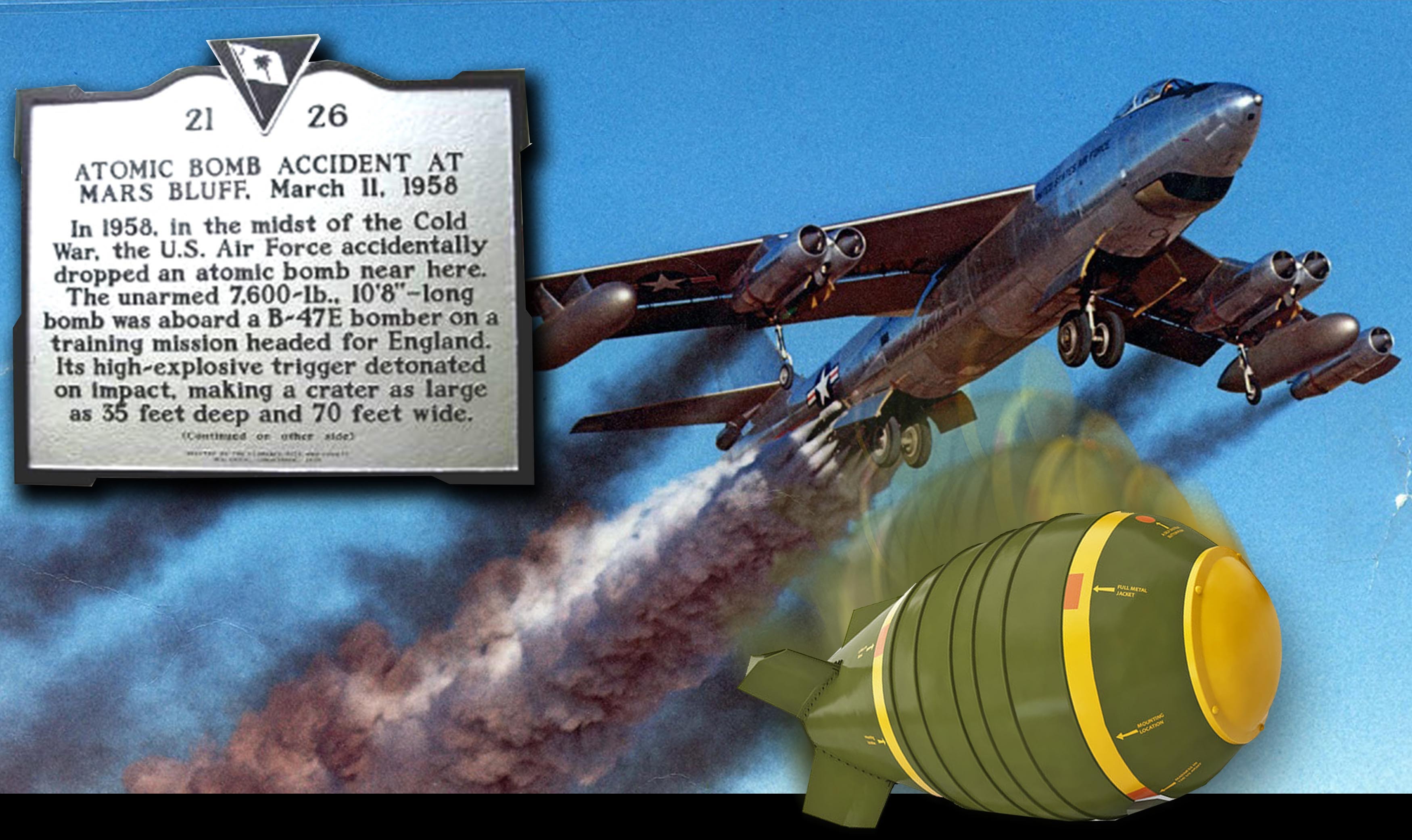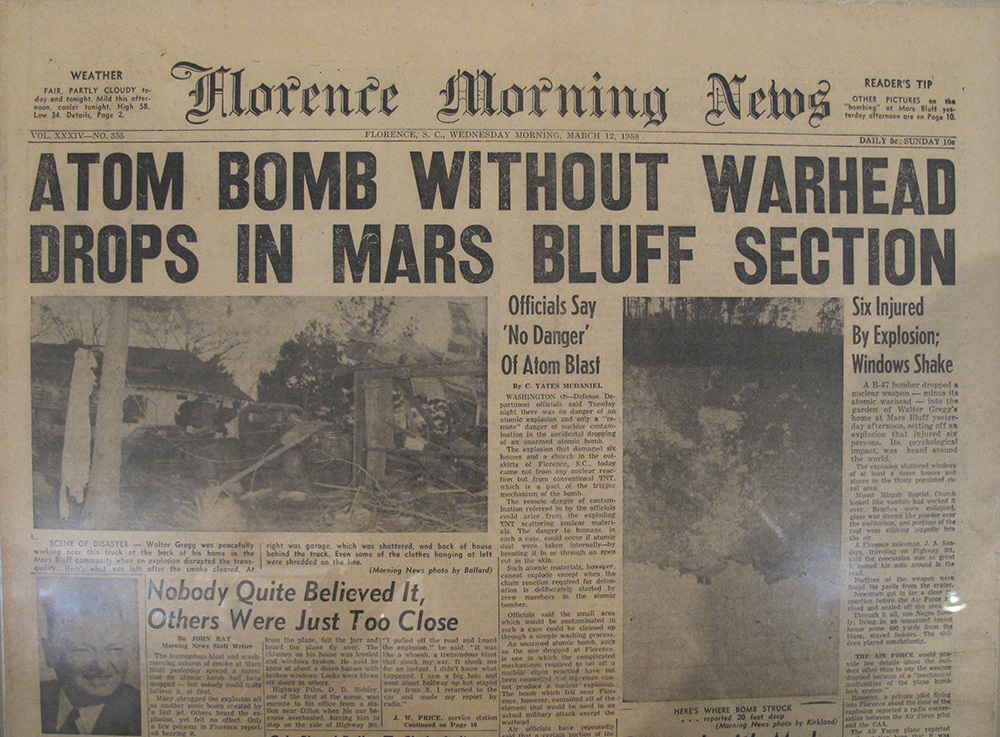Broken Arrow: The Time We Almost Nuked South Carolina – REWIND
In our history, we’ve had at least 32 “Broken Arrow” incidents: instances of nuclear weapons accidents that don’t cause a nuclear war. One of those was in 1958, in which an Air Force B-47 Bomber almost nuked Mars Bluff, South Carolina. In this episode, we talk about the B-47, it’s staggering 10% loss rate and the Mars Bluff incident. Then we catch up with actor and podcaster Michael Spedden for the Quick Quiz! This episode was originally released on May 24th of 2021.

Remember that movie, Broken Arrow? John Travolta and Christian Slater as a couple Air Force pilots whose job it is to locate some missing dropped nuclear warheads? Fun film – well it turns out Broken Arrow is the official term the military uses for an accident involving nuclear weapons. And in the 76 years since the invention of nuclear weapons in 1945, we’ve had at least 32 Broken Arrow scenarios.
For this week, we’re just going to be talking about one particular aircraft. The Boeing B-47 Stratojet. Even before the end of World War Two, the Air Force had asked manufacturers to start drawing up plans for a long range jet-powered bomber. Remember the airplane that really ended World War Two by dropping atomic bombs in Japan was the B-29, a propeller aircraft. The United States never did put any jet aircraft into combat in that war. It was still very early in the development of jet-powered flight.
The B-47 was finally put into service in 1951. It was a swept wing sleek looking bomber aircraft with 6 engines carried under its wings. And if I had to describe the problem with these aircraft, it would be that they suffered from growing pains.
There were the growing pains of jet-propelled flight itself. While the aircraft was incredibly fast and powerful, it took a very long time to accelerate. The newly designed swept wing caused structural issues. New design elements like the sweep wings and power elements like jet engines were being put on an aircraft essentially using outdated metallurgy and construction techniques. And there were a lot of limits on its capability. It was a difficult plane to fly for airmen who were used to a 10-man crew. The B-47 flew with only 3. So every moment of flight – every issue – every warning – was happening faster and with less men to tend to it. The slightest lapse in attention could now be catastrophic. Then there were the growing pains of a quickly growing air force. Ramping up mass production on the aircraft led to a few manufacturing issues. By the time they were produced, the existing refueling infrastructure didn’t meet the demands of these new long-range bombers.
They started retiring the B-47 just 18 years after it was introduced. To give you a frame of reference, the B-52 Bomber was introduced in 1955 and has yet to be retired from service 66 years later. So the B-47 Stratojet was a short-lived bomber designed to face a very real and serious threat of nuclear war. It was designed to carry nuclear bombs and could fly all the way to the Soviet Union with them.
There were just over 2,000 Stratojets manufactured. And a staggering 10% of them – 203 to be exact – were lost in crashes. And when you look at the timeline of when this aircraft was in its peak duty, it coincides with the time when aircraft started carrying nuclear weapons. That leads to the horrible events of 1957 and 1958.
The reason we spent so much time learning about the B-47 is that out of the 32 Broken Arrow events in history, 9 of them involved this aircraft. Now think back to what we learned about how short-lived this airplane’s operational lifespan was – this gives you a pretty good idea of how dangerous it really was. And it’s even crazier than that. Those 9 potential nuclear accidents happened in a period of just 3 years, from 1956 to 1958. And in 1957 and 1958, 49 of these aircraft crashed, killing a total of 122 airmen. As many problems as there were with the B-47, neither of the two stories we’re going to talk about were the fault of the aircraft.
In the dark early morning of February 5 of 1958, a B-47 Crew commanded by Air Force Colonel Howard Richardson left from Homestead Air Force Base in Florida to conducted a simulated combat mission for training. It was carrying a 7,600 pound Mark 15 nuclear bomb. In airspace nearby, Air Force Lt. Clarence Stewart was piloting his F-86 fighter jet. He didn’t see the B-47 on his radar and at approximately 2am, the two aircraft collided. With the wing missing from his small fighter jet, Lt. Stewart ejected and parachuted to safety in a swamp. For the B-47 bomber, their fuel tanks had been heavily damaged and were leaking fuel. Colonel Richardson didn’t know if he could land the bomber without the nuclear bomb detaching and detonating. He made the choice to ditch the bomb in the waters off Tybee Island in Georgia. He was able to land the plane safely at Hunter Air Base in Savannah. But that bomb landed in the Atlantic Ocean near Wassaw Sound. And as far as we know…that’s where the bomb rests, undetonated, today.
Just over one month later, on March 11 of 1958, it was the middle of the afternoon in Mars Buff, South Carolina, when six year old Helen and nine year old Frances Gregg were playing in their yard with their cousin Ella. Suddenly, a whistle from the sky and a huge explosion.

Here’s what happened. Captain Earl Koehler was piloting a B-47E Stratojet 15,000 feet in the sky over South Carolina. The crew was scheduled to fly to the United Kingdom and continue on to North Africa. This was part of an ongoing training mission to track the accuracy of mock bomb drops. Except the bombs on board were very real. Tensions with The Soviet Union were at a height and the Cold War was becoming less cold by the day. For this reason, the aircraft taking part in this training mission, ominously dubbed Operation Snow Flurry, carried live nuclear bombs in case war broke out during the missions. The bomb being carried by Captian Koehler’s B— 47 that day was similar in size to the one lost in the Atlantic in February – a 7,600 pound Mark 6 nuclear bomb.
The first indication of a problem that day was when Captain Koehler noticed an indicator light telling him that a bomb harness locking pin did not engage. This wasn’t the mechanism that held the bomb in place – it was an added safety measure. It was one of a few steps to secure it to the plane. When he noticed this indicator, the bombardier and navigator, Captain Bruce Kulka scrambled to the bomb bay area of the aircraft to check it out. As he reached around the bomb to lift himself up, he accidentally grabbed hold of the one thing he shouldn’t have. The bomb’s emergency release mechanism. <audio?> This dropped the full weight of the ten foot long, 7,600 pound bomb, along with Captain Kulka, onto the Bomb bay doors. The bombardier desperately reached his arm out to grab onto something. The bomb, however – weighed too much for the doors. He looked down through the open doors and watched in horror as the bomb started falling 15,000 feet to the land below.

The three children playing below at the Gregg house would have had no idea that the bomb was coming toward them. The Mark 6 nuclear bomb detonated 200 yards from the children. All three were injured, but none were killed. Luckily for those children, and for Mars Bluff, South Carolina, and for the South Eastern part of the United States, the nuclear capsule was not on the bomb. The capsule, which contained the fissile nuclear core, was still on-board the aircraft and hadn’t been loaded into the bomb housing.
Even so, that bomb was carrying enough explosives to blow a crater into the ground that was 70 feet wide and 30 feet deep. In addition to injuring the three girls playing, it obliterated their playhouse, injured their mother, father and brother, and damaged seven nearby buildings.
After the incident and the victims’ recovery, the Gregg family sued and was awarded $54,000 in damages. If you visit Mars Bluff, South Carolina, you can still see the crater today. It’s overgrown with trees and brush, but the site is marked with a historical marker.
As for the bomb dropped outside Tybee Island in the Atlantic Ocean? Throughout the years, the military has mounted efforts to locate the bomb – even as recently as 2004. But to this day, it’s one of 6 American nuclear weapons that have been lost and never found.
Review this podcast at https://podcasts.apple.com/us/podcast/the-internet-says-it-s-true/id1530853589
Bonus episodes and content available at http://Patreon.com/MichaelKent
For special discounts and links to our sponsors, visit http://theinternetsaysitstrue.com/deals

